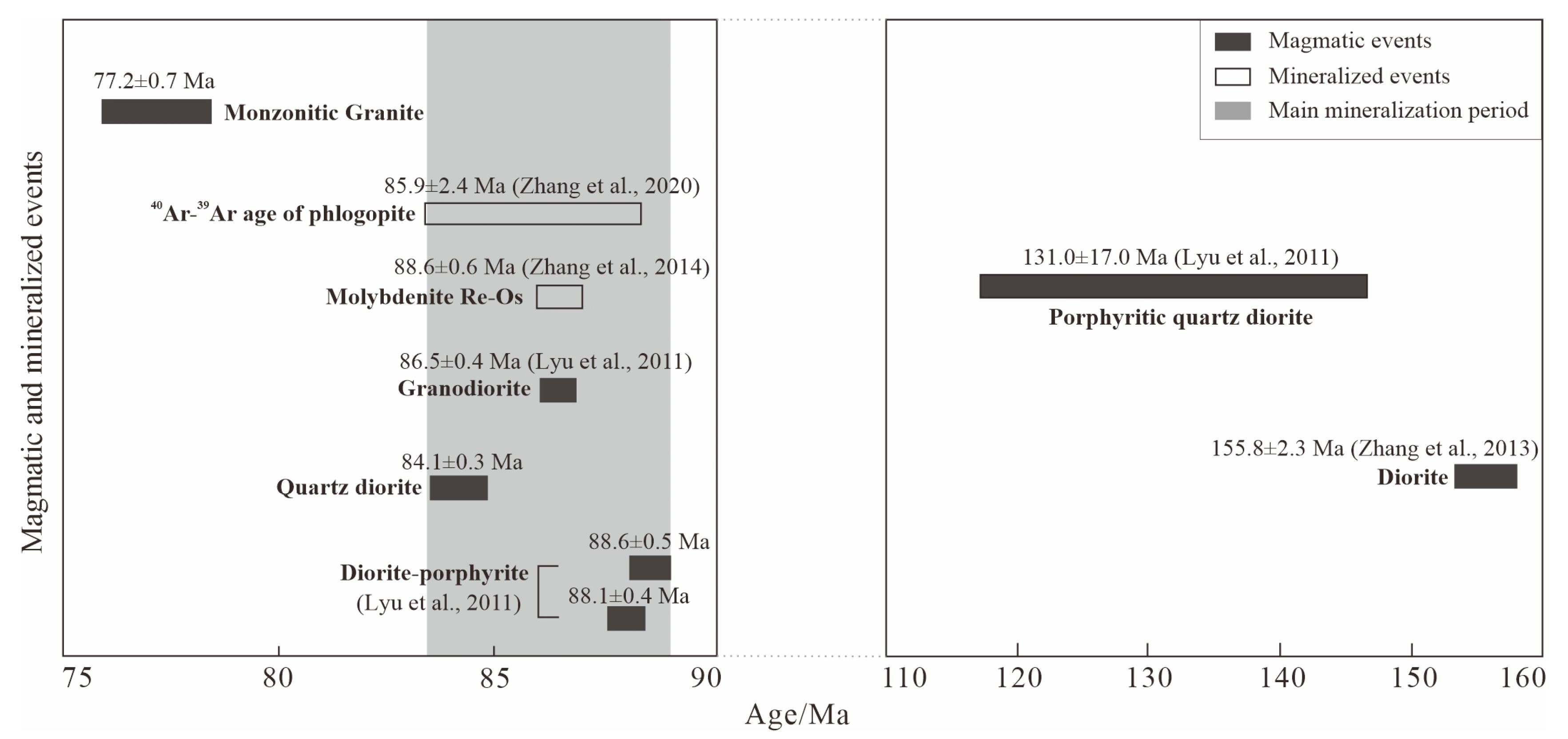Geochronology and Geochemistry of the Galale Cu–Au Deposit in the Western Segment of the Bangong–Nujiang Suture Zone: Implications for Molybdenum Potential
Abstract
1. Introduction
2. Geological Setting
3. Ore Deposit Geology
4. Sampling and Analytical Methods
4.1. Sampling
4.2. Whole-Rock Geochemistry Methods
4.3. LA-ICP-MS Zircon U–Pb Age Methods
5. Results
5.1. Zircon U–Pb Age Data
5.2. Whole-Rock Geochemistry
6. Discussion
6.1. Age Supplement of the Galale Deposit
6.2. Evaluation of Mo Mineralization Potential
- Geochemical Characteristics Relevant to Mo Fertility
- 2.
- Magma Source Discrimination
6.3. Revised Metallogenic Model
7. Conclusions
- Magmatism and mineralization in the Galale area occurred in two principal stages: an early Cretaceous phase and a more complex late Cretaceous phase. U–Pb zircon ages of 84.1 ± 0.3 Ma (syn-mineralization quartz diorite) and 77.2 ± 0.7 Ma (post-mineralization monzonitic granite) tightly constrain Late Cretaceous magmatic activity. Combined with previous data, these results indicate that mineralization took place between 83 and 89 Ma during a single magmatic–hydrothermal episode. This event postdates the closure of the Bangong–Nujiang Ocean and is attributed to post-collisional extension, likely driven by slab rollback, southward subduction, asthenospheric upwelling, and extensive crustal melting.
- The quartz diorite, granodiorite, and monzonitic granite are high-K calc-alkaline, peraluminous I-type granitoids. The quartz diorite formed in a post-collisional uplift setting and represents a relatively less evolved magma with limited Mo potential. In contrast, the granodiorite and monzonitic granite originated in a pre-collisional plate setting and exhibit highly fractionated, oxidized features, making them particularly favorable for porphyry-type molybdenum mineralization.
- The Galale deposit formed through a series of tectono-magmatic processes associated with the closure of the Bangong–Nujiang Neo-Tethys Ocean. Late Triassic subduction and Late Cretaceous lithospheric delamination induced asthenospheric upwelling and partial melting of both mantle and crustal sources, generating quartz diorite and granodiorite intrusions. These magmas underwent prolonged fractional crystallization, with exsolution of high-temperature, high-salinity fluids that interacted with carbonate strata to form skarn assemblages and precipitate ore metals along structural conduits. Hydrothermal alteration, fluid boiling, and meteoric water influx further facilitated ore deposition. The emplacement of monzonitic granite at ~77 Ma may also have contributed to additional molybdenum mineralization.
Author Contributions
Funding
Data Availability Statement
Conflicts of Interest
References
- Pan, G.T.; Wang, L.Q.; Zhu, D.C. Thoughts on some important scientific problems in regional geological survey of the Qinghai-Tibet Plateau. Geol. Bull. China 2004, 23, 12–19. [Google Scholar] [CrossRef]
- Tang, J.X.; Yang, H.H.; Li, H.W. Geological characteristics and prospecting potential analysis of Duolong porphyry-epithermal copper(gold)ore district in Tibet. China Min. Mag. 2024, 33, 1–13. [Google Scholar]
- Tang, J.; Zhang, S.; Zhang, Z.; Xue, J.; Ding, C. Final suture of the Palaeo-Asian Ocean domain: Insights from the geochemistry and geochronology of the early to Middle Permian Elitu Formation volcanics. Lithos 2024, 472–473, 107577. [Google Scholar] [CrossRef]
- Hu, W.-L.; Wang, Q.; Tang, G.-J.; Zhang, X.-Z.; Qi, Y.; Wang, J.; Ma, Y.-M.; Yang, Z.-Y.; Sun, P.; Hao, L.-L. Late Early Cretaceous magmatic constraints on the timing of closure of the Bangong–Nujiang Tethyan Ocean, Central Tibet. Lithos 2022, 416–417, 106648. [Google Scholar] [CrossRef]
- Hu, W.-L.; Wang, Q.; Tang, G.-J.; Qi, Y.; Wang, J.; Yang, Z.-Y.; Sun, P. First identification of Early Cretaceous mafic dikes in the Baingoin area, central Tibet: Implications for crust-mantle interactions and magmatic flare-up. GSA Bull. 2023, 136, 846–860. [Google Scholar] [CrossRef]
- Guo, R.; Li, S.; Yu, S.; Dai, L.; Liu, Y.; Peng, Y.; Zhou, Z.; Wang, Y.; Liu, Y.; Wang, Q.; et al. Collisional processes between the Qiangtang Block and the Lhasa Block: Insights from structural analysis of the Bangong-Nujiang Suture Zone, central Tibet. Geol. J. 2019, 54, 946–960. [Google Scholar] [CrossRef]
- Pan, G.; Wang, L.; Li, R.; Yuan, S.; Ji, W.; Yin, F.; Zhang, W.; Wang, B. Tectonic evolution of the Qinghai-Tibet Plateau. J. Asian Earth Sci. 2012, 53, 3–14. [Google Scholar] [CrossRef]
- Zhai, Q.-G.; Hu, P.-Y.; Tang, Y.; Liu, Y.-M.; Wang, W. Early Jurassic lithospheric delamination in the Amdo microcontinent, central Tibet: Inferred from coeval OIB- and MORB-like gabbros. Lithos 2023, 456–457, 107314. [Google Scholar] [CrossRef]
- Wang, W.; Zhai, Q.-G.; Hu, P.-Y.; Tang, Y.; Wang, H.-T.; Zhu, Z.-C. Magmatic records of subduction and closure of the Meso-Tethys Ocean in the northern-central Tibetan Plateau. GSA Bull. 2023, 135, 2849–2867. [Google Scholar] [CrossRef]
- Mao, J.T.; Yang, Z.S.; He, L.; Zhang, X.; Zhou, J.; Xu, Y.; Gong, X.; Pei, Y.; Ma, W. Geological features and ore-controlling factors of the Galale Cu-Au deposit in Tibet. Acta Petrol. Mineral. 2016, 35, 677–691. [Google Scholar]
- Zhang, Z.; Li, Z.-J.; Li, G.-M.; Yao, X.-F.; Zhang, L.-K.; Huang, Y.; Dong, S.-L. Geology, fluid inclusions, 40Ar/39Ar geochronology and H-O-S-Pb isotopes of the Galale CuAu deposit, Northwestern Tibet, China. J. Geochem. Explor. 2020, 214, 106547. [Google Scholar] [CrossRef]
- Zhang, Z.; Chen, Y.; Tang, J.; Song, J.; Yao, X.; He, L. Re-Os Isotopic Dating of Molybdenites in the Galale Skarn Cu-Au Deposit in Tibet and Its Geological Significance. Acta Geol. Sin.—Engl. Ed. 2014, 88 (Suppl. 2), 1049–1051. [Google Scholar] [CrossRef]
- Zhang, Z.; Tang, J.X.; Li, Z.J. Petrology and Geochemistry of Intrusive Rocks in the Ga’erqiong-Galale Ore Concentration Area, Tibet and Their Geological Implications. Geol. Explor. 2013, 49, 676–688. [Google Scholar]
- Zhang, X.; Yang, Z.S.; He, L. Ar-Ar isotopic age of phlogopite from the Galale gold-copper deposit in Tibet and its geological significance. Acta Petrol. Mineral. 2014, 33, 1127–1133. [Google Scholar]
- Zhang, Z.; Chen, Y.C.; Tang, J.X.; He, L.; Yao, X.; Hu, Z.; Wang, H.; Song, J. Geological and skarn mineral characteristics of Galale Cu-Au deposit in Tibet. Miner. Depos. 2013, 32, 915–931. [Google Scholar] [CrossRef]
- Wang, Q.; Xiao, Y.F.; Hao, Z.M.; Zhang, S.M.; Gong, T.T.; He, J.L.; He, J.J. The Occurrence of Radioactive Elements and Its Significance from Galale Copper and Gold Deposit in Bangong Co-Nujiang Metallogenic Belt. Acta Geol. Sin.—Engl. Ed. 2013, 87, 792–795. Available online: https://www.geojournals.cn/dzxbcn/dzxbcn/article/abstract/dzxben2003z10411?st=article_issue (accessed on 26 August 2025).
- Lyu, L.; Cui, Y.; Song, L.; Zhao, Y.; Qu, X.; Wang, J. Geochemical characteristics and zircon LA-ICP-MS U-Pb dating of Galale skarn gold(copper) deposit, Tibet and its significance. Earth Sci. Front. 2011, 18, 224–242. [Google Scholar]
- Zhu, D.C.; Zhao, Z.D.; Niu, Y.; Mo, X.X.; Chung, S.L.; Hou, Z.Q.; Wang, L.; Wu, F.Y. The Lhasa Terrane: Record of a microcontinent and its histories of drift and growth. Earth Planet. Sci. Lett. 2010, 301, 241–255. [Google Scholar] [CrossRef]
- Zhang, Z.; Yao, X.; Tang, J.; Li, Z.; Wang, L.; Yang, Y.; Duan, J.; Song, J.; Lin, X. Lithogeochemical, Re–Os and U–Pb Geochronological, Hf–Lu and S–Pb Isotope Data of the Ga’erqiong-Galale Cu–Au Ore-Concentrated Area: Evidence for the Late Cretaceous Magmatism and Metallogenic Event in the Bangong-Nujiang Suture Zone, North. Resour. Geol. 2015, 65, 76–102. [Google Scholar] [CrossRef]
- Geological Society of America. Yinahtm Regional Geological Records of Tibet, China; Geological Society of America: Boulder, CO, USA, 2000. [Google Scholar]
- GB/T 14506.28-2010; Chemical Analysis Methods of Silicate Rocks Part 28: Determination of 16 Major and Minor Components. China Standards Press: Beijing, China, 2010.
- DZ/T 0223-2011; Specification for the Preparation of Mine Geological Environment Protection and Restoration Plans. Ministry of Land and Resources of the People’s Republic of China: Beijing, China, 2011.
- Liu, Y.; Liu, H.C.; Li, X.H. Simultaneous and Precise Determination of 40 Trace Elements in Rock Samples Using ICP-MS. Geochimica 1996, 6, 552–558. [Google Scholar]
- Liu, Y.; Gao, S.; Hu, Z.; Gao, C.; Zong, K.; Wang, D. Continental and Oceanic Crust Recycling-induced Melt–Peridotite Interactions in the Trans-North China Orogen: U–Pb Dating, Hf Isotopes and Trace Elements in Zircons from Mantle Xenoliths. J. Petrol. 2010, 51, 392–399. [Google Scholar] [CrossRef]
- Hou, Z.Q.; Cook, N.J.; Zaw, K. Metallogenesis of the Tibetan collisional orogen: A review and introduction to the special issue. Ore Geol. Rev. 2009, 36, 2–24. [Google Scholar] [CrossRef]
- Jackson, S.E.; Pearson, N.J.; Griffin, W.L.; Belousova, E.L. The application of laser ablation-inductively coupled plasma-mass spectrometry to in situ U–Pb zircon geochronology. Chem. Geol. 2004, 211, 46–69. [Google Scholar] [CrossRef]
- Paul, A.N.; Spikings, R.A.; Gaynor, S.P. U-Pb ID-TIMS reference ages and initial Pb isotope compositions for Durango and Wilberforce apatites. Chem. Geol. 2021, 586, 120604. [Google Scholar] [CrossRef]
- Harrison, T.M.; Bell, E.A.; Boehnke, P. Hadean Zircon Petrochronology. Rev. Miner. Geochem. 2017, 83, 329–363. [Google Scholar] [CrossRef]
- Brusco, M.J.; Stahl, S. Using Quadratic Assignment Methods to Generate Initial Permutations for Least-Squares Unidimensional Scaling of Symmetric Proximity Matrices. J. Classif. 2000, 17, 197–223. [Google Scholar] [CrossRef]
- Peccerillo, A.; Taylor, S.R. Geochemistry of eocene calc-alkaline volcanic rocks from the Kastamonu area, Northern Turkey. Contrib. Miner. Petrol. 1976, 58, 63–81. [Google Scholar] [CrossRef]
- Sun, S.S.; McDonough, W.F. Chemical and isotopic systematics of oceanic basalts: Implications for mantle composition and processes. In Magmatism in the Ocean Basins; Saunders, A.D., Norry, M.J., Eds.; Geological Society of London: London, UK, 1989; pp. 313–345. [Google Scholar]
- Liu, Y.; Li, S.; Zhai, Q.; Tang, Y.; Hu, P.; Guo, R.; Liu, Y.; Wang, Y.; Yu, S.; Cao, H.; et al. Jurassic tectonic evolution of Tibetan Plateau: A review of Bangong-Nujiang Meso-Tethys Ocean. Earth-Sci. Rev. 2022, 227, 103973. [Google Scholar] [CrossRef]
- Hu, W.-L.; Wang, Q.; Yang, J.-H.; Hao, L.-L.; Wang, J.; Qi, Y.; Yang, Z.-Y.; Sun, P. Growth of the continental crust induced by slab rollback in subduction zones: Evidence from Middle Jurassic arc andesites in central Tibet. Gondwana Res. 2023, 117, 8–22. [Google Scholar] [CrossRef]
- Rollinson, H. Dunites in the mantle section of the Oman ophiolite—The boninite connection. Lithos 2019, 334–335, 8–22. [Google Scholar] [CrossRef]
- Jiang, S.; Jiang, Y.; Liu, Y.; Li, S.; Zhang, W.; Wang, G.; Lu, L.; Somerville, I. The Bangong-Nujiang Suture Zone, Tibet Plateau: Its role in the tectonic evolution of the eastern Tethys Ocean. Earth-Sci. Rev. 2021, 218, 103656. [Google Scholar] [CrossRef]
- He, H.; Li, Y.; Wang, C.; Zhou, A.; Qian, X.; Zhang, J.; Du, L.; Bi, W. Late Cretaceous (ca. 95 Ma) magnesian andesites in the Biluoco area, southern Qiangtang subterrane, central Tibet: Petrogenetic and tectonic implications. Lithos 2018, 302–303, 389–404. [Google Scholar] [CrossRef]
- Hu, X.; Ma, A.; Xue, W. Exploring a lost ocean in the Tibetan Plateau: Birth, growth, and demise of the Bangong-Nujiang Ocean. Earth-Sci. Rev. 2022, 229, 104031. [Google Scholar] [CrossRef]
- Li, Y.; He, J.; Wang, C.; Han, Z.; Ma, P.; Xu, M.; Du, K. Cretaceous volcanic rocks in south Qiangtang Terrane: Products of northward subduction of the Bangong–Nujiang Ocean? J. Asian Earth Sci. 2015, 104, 69–83. [Google Scholar] [CrossRef]
- Liu, W.; Wang, B.; Yang, X.; Yuan, S.; Liu, H.; Liao, Z. Geochronology, Geochemistry, and Sr–Nd–Hf Isotopes of the Balazha Ore-Bearing Porphyries: Implications for Petrogenesis and Geodynamic Setting of Late Cretaceous Magmatic Rocks in the Northern Lhasa Block, Tibet. Acta Geol. Sin. 2018, 92, 1739–1752. [Google Scholar] [CrossRef]
- Hou, Z.; Yang, Z.; Lu, Y.; Kemp, A.; Zheng, Y.; Li, Q.; Tang, J.; Yang, Z.; Duan, L. A genetic linkage between subduction- and collision-related porphyry Cu deposits in continental collision zones. Geology 2015, 43, 643–650. [Google Scholar] [CrossRef]
- Mo, X.; Hou, Z.; Niu, Y.; Dong, G.; Qu, X.; Zhao, Z.; Yang, Z. Mantle contributions to crustal thickening during continental collision: Evidence from Cenozoic igneous rocks in southern Tibet. Lithos 2007, 96, 225–242. [Google Scholar] [CrossRef]
- Chen, L.; Zheng, Y.-F.; Xu, Z.; Zhao, Z.-F. Generation of andesite through partial melting of basaltic metasomatites in the mantle wedge: Insight from quantitative study of Andean andesites. Geosci. Front. 2020, 12, 1015–1032. [Google Scholar] [CrossRef]
- Roberts, M.P.; Clemens, J.D. Origin of high-potassium, calc-alkaline, I-type granitoids. Geology 1993, 21, 825. [Google Scholar] [CrossRef]
- Audetat, J.F.A. The effects of pressure, fO2, fS2 and melt composition on the fluid–melt partitioning of Mo: Implications for the Mo-mineralization potential of upper crustal granitic magmas. Geochim. Cosmochim. Acta J. Geochem. Soc. Meteorit. Soc. 2022, 336, 1–14. [Google Scholar] [CrossRef]
- Erickson, B.E.; Helz, G.R. Molybdenum (VI) speciation in sulfidic waters. Geochim. Cosmochim. Acta 2000, 64, 1149–1158. [Google Scholar] [CrossRef]
- Tingle, T.N.; Fenn, P.M. Transport and concentration of molybdenum in granite molybdenite systems: Effects of fluorine and sulfur. Geology 1984, 12, 156–158. [Google Scholar] [CrossRef]
- Westra, G.; Keith, S.B. Classification and genesis of stockwork molybdenum deposits. Econ. Geol. 1981, 76, 844–873. [Google Scholar] [CrossRef]
- Andreas, A.; Li, W.T. The genesis of Climax-type porphyry Mo deposits: Insights from fluid inclusions and melt inclusions. Ore Geol. Rev. 2017, 88, 436–460. [Google Scholar] [CrossRef]
- Hovakimyan, S.; Moritz, R.; Tayan, R.; Melkonyan, R.; Harutyunyan, M. Cenozoic Strike-Slip Tectonics and Structural Controls of Porphyry Cu-Mo and Epithermal Deposits During Geodynamic Evolution of the Southernmost Lesser Caucasus, Tethyan Metallogenic Belt. Econ. Geol. Bull. Soc. Econ. Geol. 2019, 114, 1301–1337. [Google Scholar] [CrossRef]
- Cannell, J.; Cooke, D.R.; Walshe, J.L.; Stein, H. Geology, Mineralization, Alteration, and Structural Evolution of the El Teniente Porphyry Cu-Mo Deposit. Econ. Geol. 2005, 100, 979–1003. [Google Scholar] [CrossRef]
- Phyo, A.P.; Li, H.; Hu, X.-J.; Ghaderi, M.; Myint, A.Z.; Faisal, M. Geology, geochemistry, and zircon U-Pb geochronology of the Nanthila and Pedet granites in the Myeik Sn-W district, Tanintharyi region, southern Myanmar. Ore Geol. Rev. 2025, 178, 106488. [Google Scholar] [CrossRef]
- De la Roche, H.; Leterrier, J.; Grandclaude, P.; Marchal, M. A classification of volcanic and plutonic rocks using R1R2-diagram and major-element analyses—Its relationships with current nomenclature. Chem. Geol. 1980, 29, 183–210. [Google Scholar] [CrossRef]
- Fan, J.J.; Wang, Q.; Long, X.P.; Wyman, D.A.; Kerr, A.C.; Li, J.; Wang, Z.L.; Gong, L.; Xu, D.J.; Yang, Q.J.; et al. Mo isotope evidence for the significance of subducted continental crust in formation of post-collisional porphyry Cu deposits. Chem. Geol. 2025, 680, 122683. [Google Scholar] [CrossRef]
- Hou, Z.Q.; Ma, H.W.; Zaw, K. The Himalayan Yulong Porphyry Copper Belt: Product of Large-Scale Strike-Slip Faulting in Eastern Tibet. Econ. Geol. 2003, 98, 125–145. [Google Scholar]
- Berzina, A.N.; Sotnikov, V.I.; Economou-Eliopoulos, M.; Eliopoulos, D.G. Eliopoulos. Distribution of rhenium in molybdenite from porphyry Cu–Mo and Mo–Cu deposits of Russia (Siberia) and Mongolia. Ore Geol. Rev. 2005, 26, 91–113. [Google Scholar] [CrossRef]
- Wang, C.; Ding, L.; Cai, F.; Zhang, L.; Li, Z.; Yue, Y. Rifting of the Indian passive continental margin: Insights from the Langjiexue basalts in the central Tethyan Himalaya, southern Tibet. GSA Bull. 2022, 134, 2633–2648. [Google Scholar] [CrossRef]
- Hao, L.-L.; Hu, W.-L.; Wang, Q.; Kerr, A.C.; Dan, W.; Zhang, X.-Z.; Yang, Z.-Y.; Sun, P. Bangong-Nujiang Neo-Tethyan Ocean (Central Tibet): Geodynamics, Crustal Evolution, Metallogeny, and Linkages to the “Yanshan Movement”. Earth-Sci. Rev. 2025, 265, 105119. [Google Scholar] [CrossRef]
- Zi, J.; Cawood, P.A.; Fan, W.; Wang, Y.; Tohver, E. Contrasting rift and subduction-related plagiogranites in the Jinshajiang ophiolitic mélange, southwest China, and implications for the Paleo-Tethys. Tectonics 2012, 31, 112623. [Google Scholar] [CrossRef]
- Wei, T.; Yang, F.; Kang, Z.; Wei, N.; Liu, D.; Cao, Y.; Li, D.; Chen, H.; Chen, L. Geochronology, geochemistry and geological significance of volcanic rocks in the Jiega Formation, western Lhasa block, Sailipu, Tibet. Earth Sci. Front. 2019, 26, 157–168. [Google Scholar] [CrossRef]
- Zhu, D.C.; Wang, Q.; Weinberg, R.F.; Cawood, P.A.; Chung, S.L.; Zheng, Y.F.; Zhao, Z.D.; Hou, Z.Q.; Mo, X.X. Interplay between oceanic subduction and continental collision in building continental crust. Nat. Commun. 2022, 13, 7141. [Google Scholar] [CrossRef]
- Duan, W.-Y.; Li, X.-P.; Schertl, H.-P.; Willner, A.P.; Wang, S.-J.; Chen, S.; Sun, G.-M. “Hot” subduction initiation and the origin of the Yarlung-Tsangbo ophiolites, southern Tibet: New insights from ultrahigh temperature metamorphic soles. Earth Planet. Sci. Lett. 2022, 591, 117610. [Google Scholar] [CrossRef]
- Duan, W.-Y.; Li, X.-P.; Schertl, H.-P.; Willner, A.P.; Sun, G.-M. Rodingitization records from ocean-floor to high pressure metamorphism in the Xigaze ophiolite, southern Tibet. Gondwana Res. 2022, 104, 126–153. [Google Scholar] [CrossRef]
- Hou, Z.; Xu, B.; Zheng, Y.; Zheng, H.; Zhang, H. Mantle flow:The deep mechanism of large-scale growth in Tibetan Plateau. Chin. Sci. Bull. 2021, 66, 2671–2690. [Google Scholar] [CrossRef]
- Shu, Q.H.; Deng, J. The composition of magmatic-hydrothermal fluids and their related metal mineralization. Sci. China Earth Sci. 2025, 55, 207–226. [Google Scholar] [CrossRef]
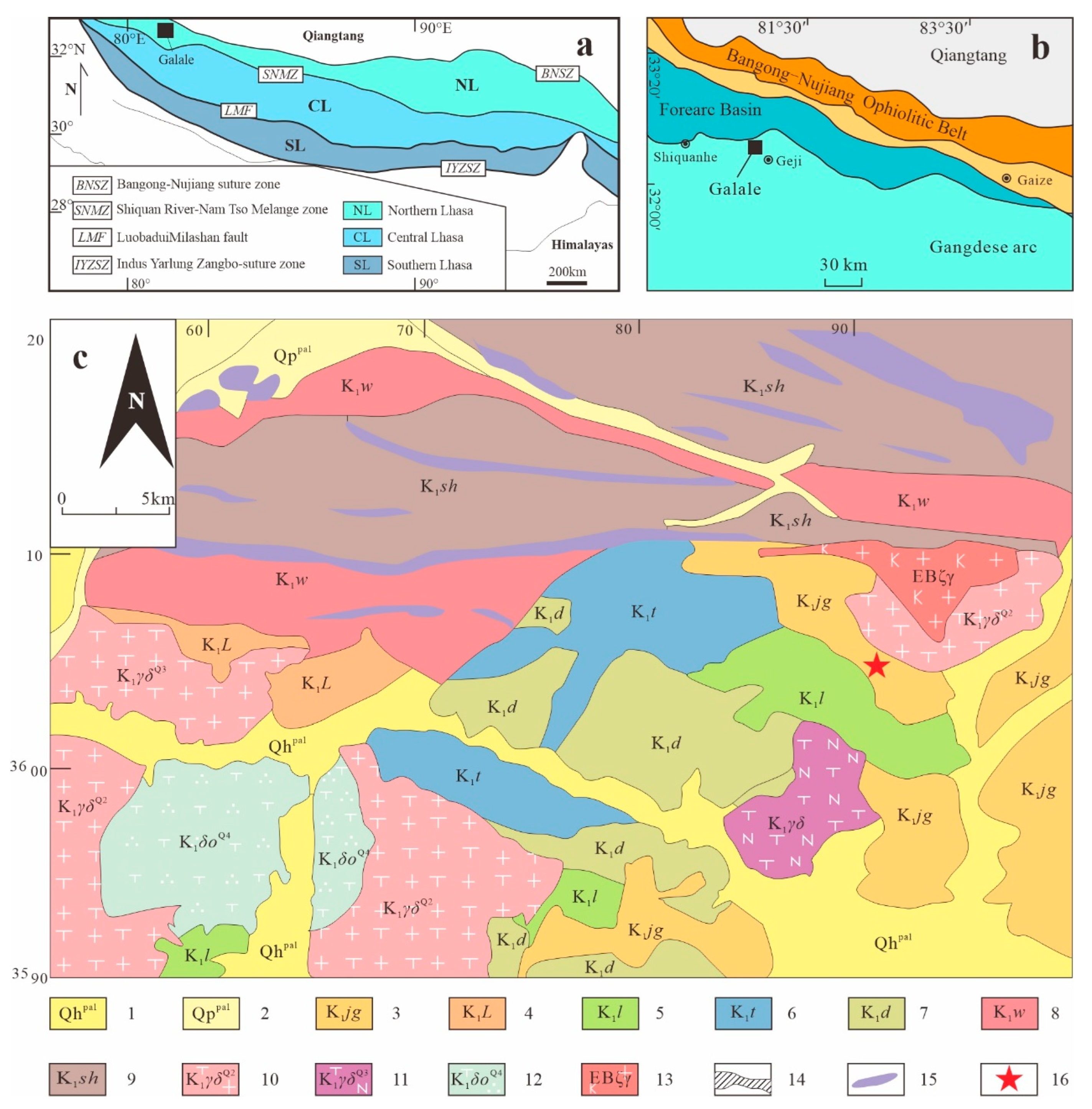
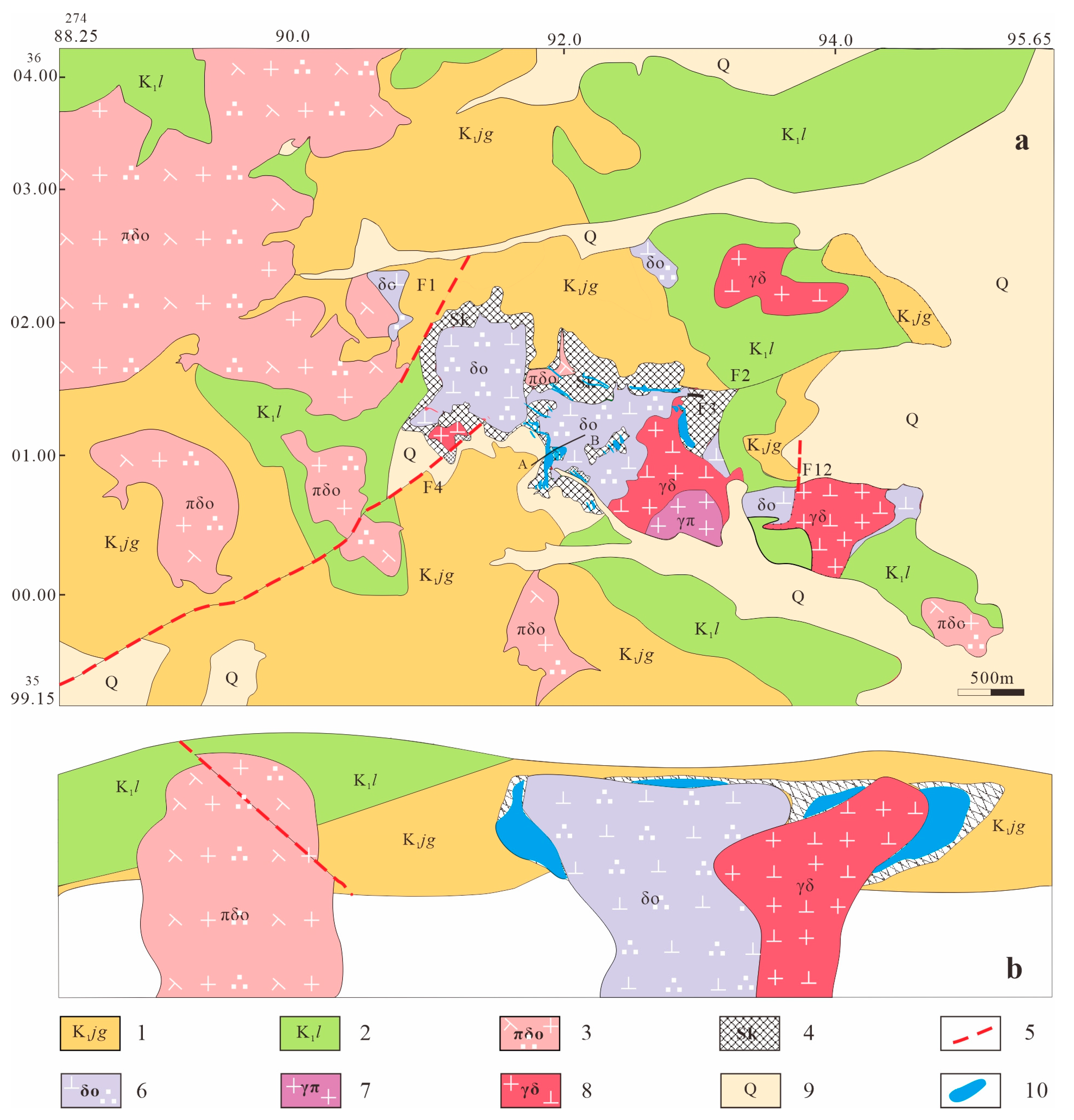
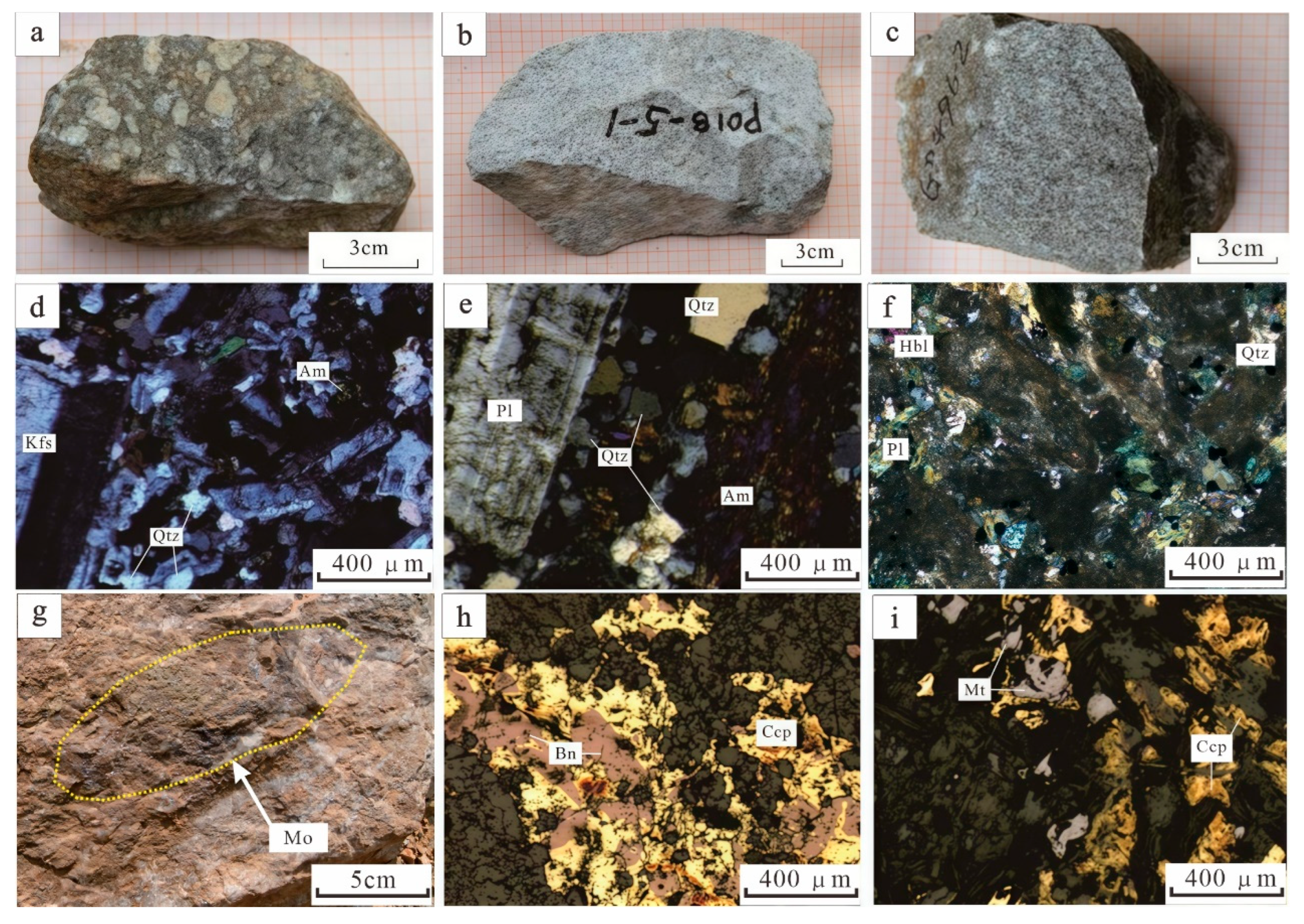
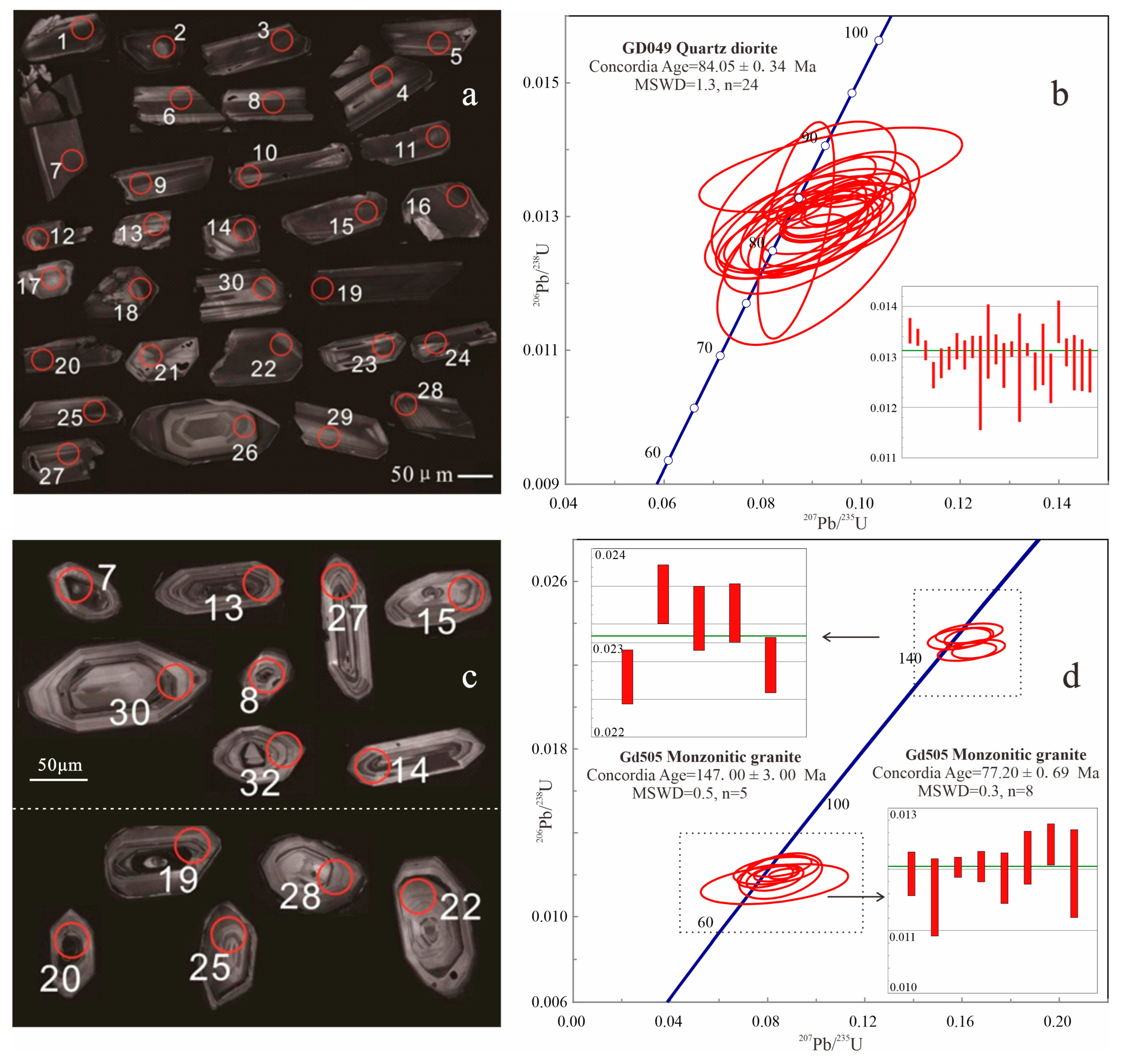
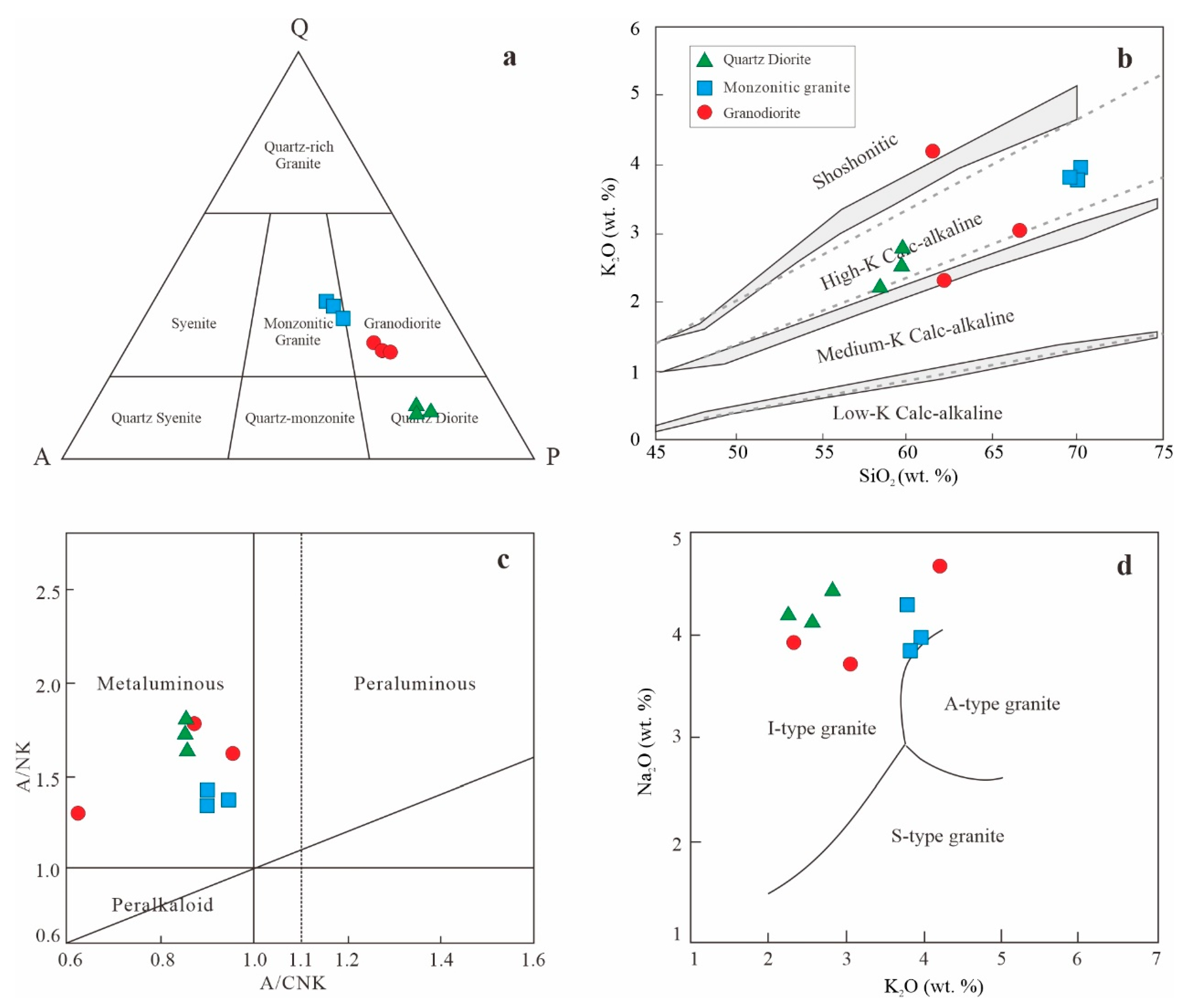
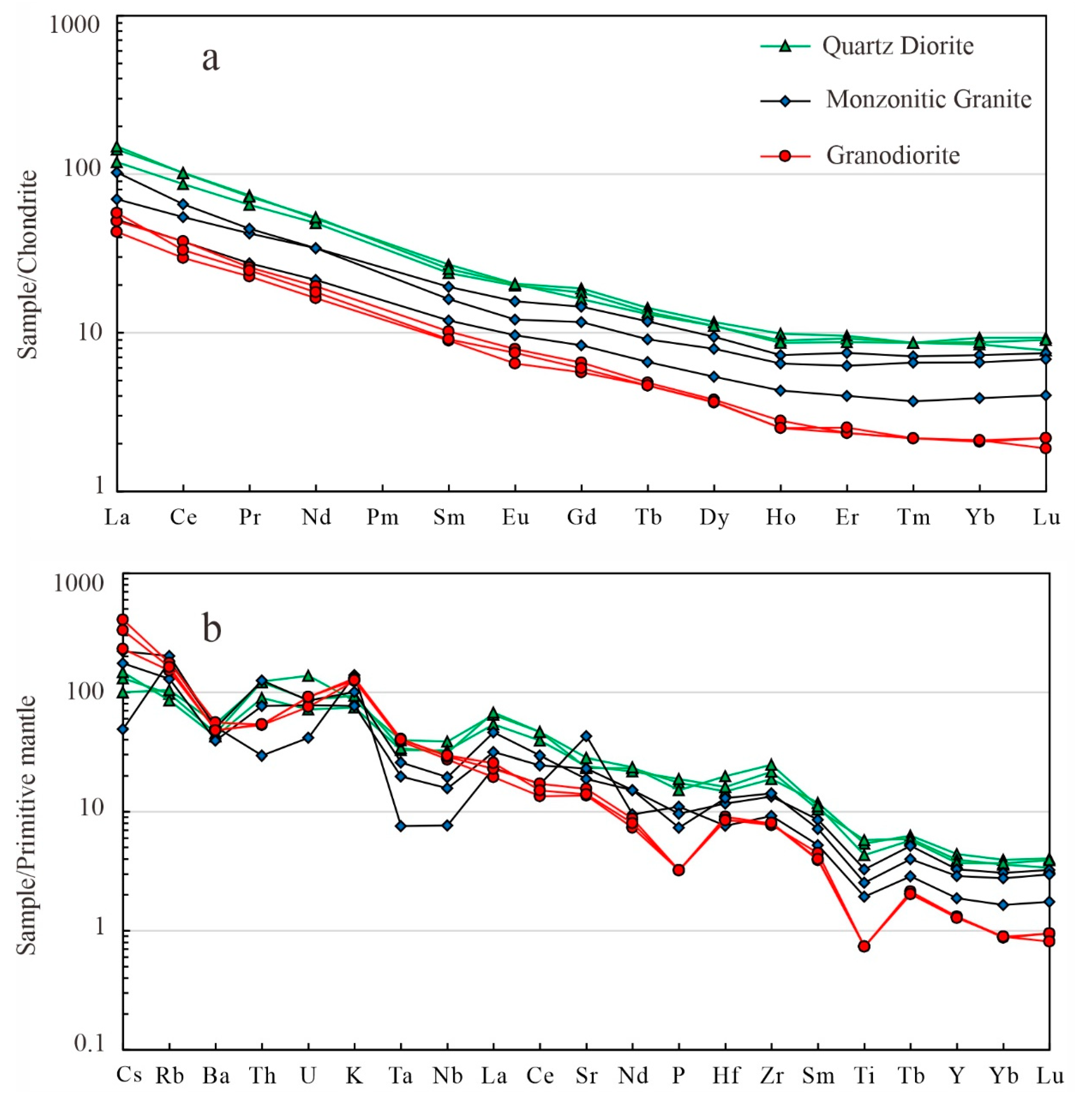
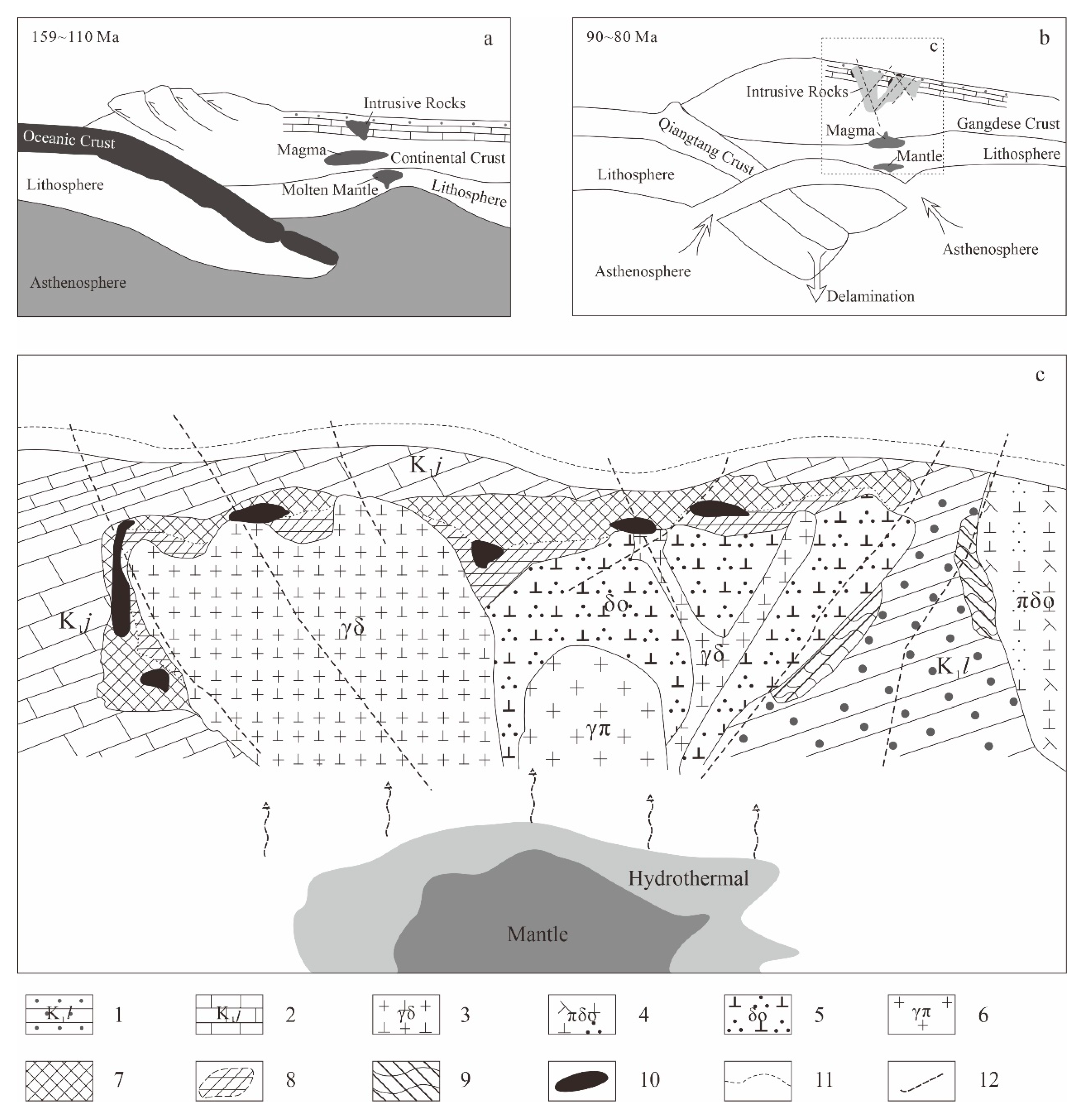
| Sample | Th/10−6 | U/10−6 | Th/U | 207Pb/206Pb | 1σ | 207Pb/235U | 1σ | 206Pb/238U | 1σ | 208Pb/232Th | 1σ | 206Pb/238U |
|---|---|---|---|---|---|---|---|---|---|---|---|---|
| Quartz diorite (GD049) | ||||||||||||
| GD049-1 | 1454.57 | 598.08 | 2.432 | 0.050998 | 0.002854 | 0.094648 | 0.005442 | 0.013522 | 0.000249 | 0.003942 | 0.000459 | 86.6 ± 1.6 |
| GD049-2 | 997.63 | 461.95 | 2.160 | 0.054474 | 0.003088 | 0.099561 | 0.005767 | 0.013393 | 0.000164 | 0.003523 | 0.000106 | 85.8 ± 1.0 |
| GD049-3 | 840.40 | 417.18 | 2.014 | 0.053276 | 0.002814 | 0.095293 | 0.005004 | 0.013135 | 0.000191 | 0.003464 | 0.000103 | 84.1 ± 1.2 |
| GD049-4 | 1015.81 | 405.16 | 2.507 | 0.052827 | 0.004044 | 0.088620 | 0.005759 | 0.012644 | 0.000257 | 0.003289 | 0.000103 | 81.0 ± 1.6 |
| GD049-5 | 763.83 | 342.27 | 2.232 | 0.056197 | 0.005930 | 0.093162 | 0.008784 | 0.012878 | 0.000290 | 0.003155 | 0.000103 | 82.5 ± 1.8 |
| GD049-6 | 814.58 | 414.93 | 1.963 | 0.055083 | 0.004059 | 0.094188 | 0.006660 | 0.012979 | 0.000226 | 0.003206 | 0.000103 | 83.1 ± 1.4 |
| GD049-7 | 633.28 | 315.99 | 2.004 | 0.051981 | 0.003826 | 0.093627 | 0.007165 | 0.013217 | 0.000256 | 0.003217 | 0.000121 | 84.6 ± 1.6 |
| GD049-8 | 1058.88 | 430.48 | 2.460 | 0.054685 | 0.004601 | 0.094882 | 0.007499 | 0.013044 | 0.000285 | 0.003187 | 0.000109 | 83.5 ± 1.8 |
| GD049-9 | 988.90 | 403.60 | 2.450 | 0.053464 | 0.002695 | 0.095741 | 0.004801 | 0.013202 | 0.000217 | 0.003060 | 0.000106 | 84.6 ± 1.4 |
| GD049-10 | 546.68 | 427.61 | 1.278 | 0.055524 | 0.007982 | 0.090388 | 0.012928 | 0.012489 | 0.000930 | 0.003100 | 0.000262 | 80.0 ± 5.9 |
| GD049-11 | 513.32 | 388.42 | 1.321 | 0.048458 | 0.007000 | 0.088290 | 0.012302 | 0.013311 | 0.000731 | 0.003319 | 0.000457 | 85.2 ± 4.6 |
| GD049-12 | 1173.84 | 490.73 | 2.392 | 0.053809 | 0.003613 | 0.093538 | 0.006178 | 0.013154 | 0.000293 | 0.003081 | 0.000105 | 84.2 ± 1.9 |
| GD049-13 | 916.45 | 446.68 | 2.052 | 0.052534 | 0.007545 | 0.091543 | 0.012796 | 0.012835 | 0.000439 | 0.002847 | 0.000136 | 82.2 ± 2.8 |
| GD049-14 | 1660.95 | 855.97 | 1.940 | 0.049433 | 0.001875 | 0.087961 | 0.003300 | 0.013157 | 0.000147 | 0.003220 | 0.000105 | 84.3 ± 0.9 |
| GD049-15 | 514.03 | 269.29 | 1.909 | 0.038910 | 0.003470 | 0.086742 | 0.005090 | 0.012792 | 0.001069 | 0.003538 | 0.000264 | 81.9 ± 6.8 |
| GD049-16 | 3737.12 | 1198.56 | 3.118 | 0.047168 | 0.001665 | 0.084331 | 0.002912 | 0.013150 | 0.000123 | 0.003414 | 0.000105 | 84.2 ± 0.8 |
| GD049-17 | 1420.14 | 613.99 | 2.313 | 0.052076 | 0.007083 | 0.086716 | 0.010333 | 0.012718 | 0.000371 | 0.003617 | 0.000168 | 81.5 ± 2.4 |
| GD049-18 | 622.70 | 349.88 | 1.780 | 0.053612 | 0.006699 | 0.093607 | 0.011954 | 0.013054 | 0.000604 | 0.003843 | 0.000265 | 83.6 ± 3.8 |
| GD049-19 | 753.47 | 409.73 | 1.839 | 0.051997 | 0.006781 | 0.087994 | 0.010483 | 0.012580 | 0.000486 | 0.003534 | 0.000198 | 80.6 ± 3.1 |
| GD049-20 | 1195.49 | 550.54 | 2.171 | 0.046557 | 0.008036 | 0.093779 | 0.017583 | 0.013699 | 0.000417 | 0.003759 | 0.000206 | 87.7 ± 2.7 |
| GD049-21 | 1194.01 | 533.57 | 2.238 | 0.053487 | 0.004054 | 0.094511 | 0.006897 | 0.013095 | 0.000272 | 0.003637 | 0.000137 | 83.9 ± 1.7 |
| GD049-22 | 903.76 | 471.99 | 1.915 | 0.052348 | 0.008760 | 0.089138 | 0.013760 | 0.012890 | 0.000543 | 0.003373 | 0.000185 | 82.6 ± 3.5 |
| GD049-23 | 791.52 | 348.16 | 2.273 | 0.049260 | 0.005546 | 0.085770 | 0.010069 | 0.012841 | 0.000508 | 0.003275 | 0.000269 | 82.3 ± 3.2 |
| GD049-24 | 360.81 | 234.31 | 1.540 | 0.050200 | 0.004314 | 0.089221 | 0.008035 | 0.012734 | 0.000429 | 0.003225 | 0.000196 | 81.6 ± 2.7 |
| Monzonitic granite (GD505) | ||||||||||||
| GD505-1 | 1875.14 | 728.22 | 2.575 | 0.048137 | 0.004737 | 0.079057 | 0.007557 | 0.011929 | 0.000356 | 0.002904 | 0.000391 | 76.4 ± 2.3 |
| GD505-2 | 528.49 | 453.34 | 1.166 | 0.050566 | 0.011026 | 0.082843 | 0.020026 | 0.011545 | 0.000630 | 0.003080 | 0.000477 | 74.0 ± 4.0 |
| GD505-3 | 652.73 | 646.93 | 1.009 | 0.052939 | 0.002623 | 0.086694 | 0.004074 | 0.012036 | 0.000164 | 0.002889 | 0.000444 | 77.1 ± 1.0 |
| GD505-4 | 348.97 | 379.72 | 0.919 | 0.052733 | 0.004258 | 0.083742 | 0.006123 | 0.012047 | 0.000248 | 0.002886 | 0.000401 | 77.2 ± 1.6 |
| GD505-5 | 206.65 | 250.92 | 0.823 | 0.051542 | 0.005143 | 0.083026 | 0.007740 | 0.011858 | 0.000412 | 0.002848 | 0.000360 | 76.0 ± 2.6 |
| GD505-6 | 378.26 | 582.32 | 0.650 | 0.052293 | 0.002507 | 0.162089 | 0.007983 | 0.022641 | 0.000286 | 0.005695 | 0.000298 | 144.3 ± 1.8 |
| GD505-7 | 616.16 | 421.42 | 1.462 | 0.051047 | 0.003019 | 0.163010 | 0.009120 | 0.023518 | 0.000311 | 0.005785 | 0.000253 | 149.9 ± 2.0 |
| GD505-8 | 195.07 | 697.89 | 0.280 | 0.049025 | 0.002426 | 0.158863 | 0.008562 | 0.023262 | 0.000339 | 0.005685 | 0.000270 | 148.2 ± 2.1 |
| GD505-9 | 264.64 | 343.50 | 0.770 | 0.051547 | 0.002162 | 0.162825 | 0.006683 | 0.023319 | 0.000309 | 0.006406 | 0.000179 | 148.6 ± 1.9 |
| GD505-10 | 300.43 | 348.89 | 0.861 | 0.049058 | 0.006172 | 0.083488 | 0.011583 | 0.012192 | 0.000431 | 0.003712 | 0.000221 | 78.1 ± 2.7 |
| GD505-11 | 200.25 | 219.61 | 0.912 | 0.053727 | 0.002317 | 0.166810 | 0.007208 | 0.022767 | 0.000293 | 0.006424 | 0.000196 | 145.1 ± 1.8 |
| GD505-12 | 275.98 | 578.61 | 0.477 | 0.050825 | 0.005889 | 0.084918 | 0.008723 | 0.012409 | 0.000335 | 0.004612 | 0.000239 | 79.5 ± 2.1 |
| GD505-13 | 260.38 | 316.68 | 0.822 | 0.055145 | 0.008185 | 0.085414 | 0.011258 | 0.011933 | 0.000717 | 0.003861 | 0.000382 | 76.5 ± 4.6 |
| Lithologic Map | Quartz Diorite | Granodiorite | Monzonitic Granite | ||||||
|---|---|---|---|---|---|---|---|---|---|
| NO. | GD049-2 | GD049-3 | GD496-1 | P01B-9-1 | P01B-16-3 | P01B-19-1 | GD505-2 | GD505-3 | GD505-4 |
| SiO2 | 59.50 | 58.22 | 59.56 | 61.34 | 62.02 | 66.50 | 69.93 | 70.13 | 69.47 |
| TiO2 | 1.17 | 1.25 | 0.94 | 0.42 | 0.71 | 0.55 | 0.16 | 0.16 | 0.16 |
| Al2O3 | 16.66 | 16.99 | 17.06 | 15.89 | 15.99 | 15.22 | 14.91 | 14.79 | 14.87 |
| Fe2O3 | 2.81 | 3.13 | 3.07 | 0.48 | 2.47 | 1.50 | 0.24 | 0.37 | 0.32 |
| FeO | 3.24 | 3.44 | 2.63 | 1.90 | 2.62 | 1.89 | 0.37 | 0.27 | 0.23 |
| MnO | 0.10 | 0.12 | 0.10 | 0.07 | 0.09 | 0.05 | 0.01 | 0.01 | 0.01 |
| MgO | 3.02 | 3.17 | 2.83 | 2.48 | 3.09 | 1.85 | 0.24 | 0.50 | 0.24 |
| CaO | 5.42 | 5.75 | 5.21 | 7.29 | 5.16 | 3.59 | 2.96 | 2.64 | 3.30 |
| Na2O | 4.15 | 4.22 | 4.46 | 4.68 | 3.93 | 3.72 | 4.30 | 3.98 | 3.85 |
| K2O | 2.55 | 2.24 | 2.81 | 4.19 | 2.31 | 3.04 | 3.77 | 3.95 | 3.81 |
| P2O5 | 0.38 | 0.41 | 0.33 | 0.24 | 0.21 | 0.16 | 0.07 | 0.07 | 0.07 |
| H2O+ | 0.58 | 0.68 | 0.62 | 0.40 | 1.12 | 1.34 | 1.36 | 1.14 | 1.70 |
| CO2 | 0.16 | 0.17 | 0.16 | 0.16 | 0.10 | 0.50 | 1.78 | 2.05 | 2.07 |
| LOI | 0.56 | 0.59 | 0.51 | 0.43 | 1.10 | 1.47 | 2.70 | 3.00 | 3.23 |
| A/CNK | 0.86 | 0.86 | 0.86 | 0.62 | 0.87 | 0.95 | 0.90 | 0.95 | 0.90 |
| A/NK | 1.74 | 1.81 | 1.64 | 1.30 | 1.78 | 1.62 | 1.34 | 1.37 | 1.42 |
| K2O/Na2O | 0.61 | 0.53 | 0.63 | 0.90 | 0.59 | 0.82 | 0.88 | 0.99 | 0.99 |
| Cs | 4.19 | 4.71 | 3.21 | 1.57 | 5.60 | 7.08 | 7.37 | 13.0 | 10.6 |
| Rb | 61.5 | 54.2 | 66.3 | 116 | 82.1 | 128 | 96.8 | 112 | 103 |
| Ba | 316 | 298 | 380 | 357 | 274 | 352 | 337 | 390 | 335 |
| Th | 10.5 | 7.61 | 10.3 | 2.51 | 6.54 | 10.7 | 4.51 | 4.54 | 4.56 |
| U | 2.90 | 1.51 | 1.81 | 0.87 | 1.63 | 1.79 | 1.58 | 1.92 | 1.92 |
| Nb | 27.5 | 23.2 | 22.2 | 5.46 | 11.2 | 13.9 | 19.5 | 20.6 | 21.0 |
| Ta | 1.62 | 1.34 | 1.39 | 0.31 | 0.81 | 1.06 | 1.58 | 1.66 | 1.64 |
| Sr | 493 | 507 | 594 | 904 | 487 | 397 | 289 | 327 | 296 |
| Zr | 211 | 243 | 278 | 103 | 150 | 160 | 89.2 | 86.3 | 89.9 |
| Hf | 4.58 | 4.98 | 6.13 | 2.36 | 3.62 | 4.02 | 2.8 | 2.64 | 2.61 |
| Y | 20.0 | 17.9 | 16.9 | 8.53 | 14.9 | 13.1 | 5.94 | 5.96 | 5.84 |
| Sr/Y | 24.7 | 28.3 | 35.1 | 106.0 | 32.7 | 30.3 | 48.7 | 54.9 | 50.7 |
| La | 44.3 | 36.9 | 46.3 | 16 | 21.6 | 31.7 | 13.4 | 15.7 | 17.6 |
| Ce | 82.4 | 69.9 | 82.2 | 30.3 | 43.4 | 52.2 | 23.9 | 30.5 | 26.8 |
| Pr | 8.97 | 7.81 | 8.78 | 3.35 | 5.15 | 5.52 | 2.76 | 3.16 | 3.01 |
| Nd | 31.4 | 29.5 | 32 | 12.9 | 20.5 | 20.5 | 9.91 | 11.8 | 10.8 |
| Sm | 5.25 | 4.64 | 4.93 | 2.33 | 3.79 | 3.18 | 1.74 | 1.99 | 1.77 |
| Eu | 1.5 | 1.46 | 1.49 | 0.71 | 1.16 | 0.89 | 0.47 | 0.58 | 0.55 |
| Gd | 4.92 | 4.64 | 4.23 | 2.16 | 3.78 | 3.03 | 1.46 | 1.68 | 1.55 |
| Tb | 0.68 | 0.64 | 0.62 | 0.31 | 0.56 | 0.43 | 0.22 | 0.23 | 0.22 |
| Dy | 3.77 | 3.57 | 3.56 | 1.7 | 3.04 | 2.55 | 1.17 | 1.22 | 1.18 |
| Ho | 0.71 | 0.64 | 0.62 | 0.31 | 0.52 | 0.46 | 0.18 | 0.2 | 0.18 |
| Er | 2.01 | 1.94 | 1.83 | 0.84 | 1.57 | 1.3 | 0.49 | 0.49 | 0.53 |
| Tm | 0.28 | 0.28 | 0.28 | 0.12 | 0.23 | 0.21 | 0.07 | 0.07 | 0.07 |
| Yb | 1.94 | 1.77 | 1.82 | 0.81 | 1.51 | 1.36 | 0.43 | 0.44 | 0.44 |
| Lu | 0.3 | 0.25 | 0.29 | 0.13 | 0.24 | 0.22 | 0.07 | 0.07 | 0.06 |
| ΣREE | 188.43 | 163.94 | 188.95 | 71.97 | 107.05 | 123.55 | 56.27 | 68.13 | 64.76 |
| (La/Yb)N | 15.40 | 14.06 | 17.15 | 13.32 | 9.64 | 15.71 | 21.01 | 24.06 | 26.97 |
| δEu | 0.89 | 0.95 | 0.97 | 0.95 | 0.93 | 0.86 | 0.88 | 0.95 | 0.99 |
Disclaimer/Publisher’s Note: The statements, opinions and data contained in all publications are solely those of the individual author(s) and contributor(s) and not of MDPI and/or the editor(s). MDPI and/or the editor(s) disclaim responsibility for any injury to people or property resulting from any ideas, methods, instructions or products referred to in the content. |
© 2025 by the authors. Licensee MDPI, Basel, Switzerland. This article is an open access article distributed under the terms and conditions of the Creative Commons Attribution (CC BY) license (https://creativecommons.org/licenses/by/4.0/).
Share and Cite
Liu, C.; Yang, Z.; Zhao, X.; Mao, J. Geochronology and Geochemistry of the Galale Cu–Au Deposit in the Western Segment of the Bangong–Nujiang Suture Zone: Implications for Molybdenum Potential. Minerals 2025, 15, 975. https://doi.org/10.3390/min15090975
Liu C, Yang Z, Zhao X, Mao J. Geochronology and Geochemistry of the Galale Cu–Au Deposit in the Western Segment of the Bangong–Nujiang Suture Zone: Implications for Molybdenum Potential. Minerals. 2025; 15(9):975. https://doi.org/10.3390/min15090975
Chicago/Turabian StyleLiu, Chang, Zhusen Yang, Xiaoyan Zhao, and Jingtao Mao. 2025. "Geochronology and Geochemistry of the Galale Cu–Au Deposit in the Western Segment of the Bangong–Nujiang Suture Zone: Implications for Molybdenum Potential" Minerals 15, no. 9: 975. https://doi.org/10.3390/min15090975
APA StyleLiu, C., Yang, Z., Zhao, X., & Mao, J. (2025). Geochronology and Geochemistry of the Galale Cu–Au Deposit in the Western Segment of the Bangong–Nujiang Suture Zone: Implications for Molybdenum Potential. Minerals, 15(9), 975. https://doi.org/10.3390/min15090975





